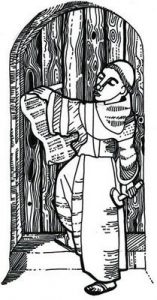Reformation 500
The 31st October 2017, will mark 500 years since Martin Luther nailed his “95 These,” to the door of All Saints Church in Wittenberg Germany, so triggering the process, that would lead to The Reformation. Not that he set out to do this in the beginning. He was a Catholic priest and Augustinian monk, who wanted to reform the Catholic Church from the inside, by addressing its teachings on indulgences, and preoccupation with material wealth.
Luther saw that the abuse of the sale of indulgences – promoted as fast track tickets to heaven – as unwarranted by scripture, and more to do with funding the building of St Peter’s in Rome than salvation. He felt that it encouraged people to carry on leading a sinful life and turned them away from Christ and God’s forgiveness.
Luther declared that when it came to justification – the action of making righteous in the sight of God – there could be no mediation, no brokering by the church, as salvation was a matter between the individual and God. Human kind was justified by faith in Christ and not by works. He passionately believed that by the action of God alone, in the death and resurrection of Christ, people were called from sin to a new life in Christ.
In questioning the supremacy of The Pope and the infallibility of the Church Councils, Luther was excommunicated from the church in 1520 and outlawed from the country by Emperor Charles in 1521. He was already in dispute with his Augustinian Order and he took refuge in Wartburg Castle under the protection of Fredrick of Saxony. Here he devoted his time to translating the Bible into German, for people to see the truth of his argument for themselves.
Assisted greatly by the invention of the printing press and his prolific ability to write and question, his revolutionary zeal spread. The Catholic Church launched a counter reformation, but by the end of the 16th century almost all of Northern Europe was Protestant, even if they were splintered into different factions.
As well as bloodshed, the Reformation was used to justify the terrible destruction of religious heritage and art. In England, more than 800 monasteries, abbeys, nunneries and friaries were seized, with works of art destroyed or appropriated. A lot of beauty and heritage was lost, which grieves me terribly, but it also gave rise to new forms of literature and music, which peaked in the work of JS Bach. His melodies and musical style borrowed heavily form the Catholic tradition, but the focus of his chorales and Passions were always on the freely given gift of Christ’s sacrifice for us, by which salvation is achieved.
It is from the words Bach’s St Matthew’s Passion that I conclude
O sacred head sore wounded,
with grief and pain weighed down,
how scornfully surrounded with thorns,
thine only crown.
How pale though art with anguish,
with sore abuse and scorn!
How does that visage languish
which once was bright as mourn.
O Lord of life and glory,
what bliss till now was thine!
I read the wondrous story,
I joy to call thee mine.
Thy grief and thy compassion
were all for sinners gain;
mine, mine was the transgression,
but thine the deadly pain.
Paul Gerhardt (1607 -1676)
Harmonised by JS Bach (1685 -1750)
Singing the Faith 280

